Not A Single-Group Group Function
Definition and Explanation:
Not a single-group group function is a term that is commonly used in SQL programming. In SQL, a group function is a function that performs calculations on sets of rows rather than individual rows. These functions typically require a GROUP BY clause in the SQL statement to specify the grouping criteria.
A not a single-group group function is a group function that cannot be used without the GROUP BY clause. This means that the function operates on a group of rows and produces a single result, but it needs to know how to group the rows before it can produce the result.
Characteristics and Examples:
One common example of a not a single-group group function is the COUNT function. The COUNT function is used to count the number of rows in a given set of data. However, in order to use the COUNT function, you must specify the grouping criteria using the GROUP BY clause.
For example, let’s say we have a table called “sales” with columns “product” and “quantity_sold”. If we want to count the number of products sold for each product category, we would write the following SQL statement:
SELECT product, COUNT(quantity_sold)
FROM sales
GROUP BY product;
In this example, the COUNT function is used to calculate the number of products sold, but it cannot be used without the GROUP BY clause, which specifies the grouping criteria as the “product” column.
Another example of a not a single-group group function is the LISTAGG function. The LISTAGG function is used to concatenate the values from multiple rows into a single string. Like the COUNT function, the LISTAGG function requires a GROUP BY clause to determine the grouping criteria.
For example, let’s say we have a table called “students” with columns “name” and “subject”. If we want to list all the subjects that each student has taken, we would write the following SQL statement:
SELECT name, LISTAGG(subject, ‘, ‘) WITHIN GROUP (ORDER BY subject)
FROM students
GROUP BY name;
In this example, the LISTAGG function is used to concatenate the subjects for each student, but it needs the GROUP BY clause to determine the grouping criteria as the “name” column.
Benefits and Advantages of Utilizing Not a Single-Group Group Functions:
There are several benefits and advantages to utilizing not a single-group group functions in SQL:
1. Aggregation: Not a single-group group functions allow for aggregating data based on specific criteria. This can be useful for summarizing large datasets and extracting meaningful insights.
2. Efficiency: By using not a single-group group functions, you can perform complex calculations and manipulations on large datasets in a single query, reducing the need for multiple queries and improving overall efficiency.
3. Simplified Queries: By utilizing not a single-group group functions, you can simplify queries by performing calculations and manipulations within a single statement, rather than implementing complex logic in application code.
Challenges and Limitations of Implementing Not a Single-Group Group Functions:
While not a single-group group functions offer notable benefits, there are also some challenges and limitations to consider:
1. Grouping Criteria: One limitation is the requirement for specifying the grouping criteria using the GROUP BY clause. This can result in complex SQL statements if multiple columns need to be grouped or hierarchical relationships need to be considered.
2. Performance: Using not a single-group group functions on large datasets can impact performance. Aggregating data over large sets may require extensive computational resources and can result in slower query execution times.
3. Data Integrity: Improper usage of not a single-group group functions may introduce inaccuracies in the output. Care should be taken to ensure that the grouping criteria accurately represent the desired data aggregation.
Strategies and Best Practices for Effectively Using Not a Single-Group Group Functions:
To effectively use not a single-group group functions in SQL, consider the following strategies and best practices:
1. Understand the Data: Gain a thorough understanding of the data being queried, including the relationships between tables, potential hierarchies, and the desired results. This will help in determining the appropriate grouping criteria.
2. Plan Ahead: Before employing not a single-group group functions, carefully plan the query structure. Consider the columns that need to be included in the GROUP BY clause and ensure they align with the desired grouping criteria.
3. Optimize Query Performance: When working with large datasets, optimize query performance by utilizing proper indexing, tuning, and other database optimization techniques. This can help mitigate potential performance issues associated with not a single-group group functions.
Real-Life Applications and Case Studies Demonstrating the Use of Not a Single-Group Group Functions:
Not a single-group group functions find applications in various real-life scenarios. Let’s explore a few examples:
1. E-commerce: In an e-commerce platform, not a single-group group functions can be used to calculate the average order value for each customer segment, helping businesses understand the purchasing patterns of different customer groups.
2. Financial Analysis: In finance, not a single-group group functions can be used to calculate the total expenses and average monthly expenditures for different cost centers, enabling organizations to identify areas for cost optimization.
3. Customer Support Analytics: For customer support analytics, not a single-group group functions can help in determining the average resolution time for different types of customer issues, allowing businesses to optimize their support processes.
Conclusion:
Not a single-group group functions in SQL are powerful tools for aggregating and manipulating data in a query. While they require the GROUP BY clause to specify the grouping criteria, they offer numerous benefits such as data aggregation, query simplification, and improved efficiency. By understanding the characteristics, examples, benefits, challenges, and best practices of using not a single-group group functions, SQL developers can harness their potential and leverage them effectively in various real-life applications.
Ora-00937: Not A Single-Group Group Function – Oracle Database 12C Error Messages
What Is Not A Single Group Group Function?
In the world of database management systems, functions play a crucial role in manipulating and analyzing data. One such category of functions are the group functions, which are specifically designed to perform calculations on sets of rows rather than individual rows. However, there is a subcategory of functions that do not fall under the umbrella of single group functions. In this article, we will delve deeper into this concept, exploring what exactly is not a single group function, how it differs from other group functions, and provide some commonly asked questions regarding this topic.
To understand what is not a single group function, let’s first revisit the concept of group functions. Group functions, commonly known as aggregate functions, perform calculations on a set of rows together and return a single value as a result. Examples of group functions include SUM, AVG, COUNT, MAX, and MIN. These functions are primarily used in queries that involve grouping rows with the GROUP BY clause.
However, not all functions that operate on groups of rows fall into the category of single group functions. Functions that require individual row values to perform computations, such as mathematical or string functions, are not considered single group functions. These functions operate on each row independently and do not directly derive their results from the entire group of rows. Instead, they process individual rows one by one and produce separate outputs for each row.
These non-single group functions are primarily used to either format the output data or manipulate individual rows before aggregating them with group functions. For instance, the CONCAT function, which concatenates two strings, is commonly used to consolidate values from different columns before applying group functions. Similarly, the TO_CHAR function in databases like Oracle converts a numeric value into a formatted string, allowing for better readability in the final output.
It is crucial to note that the distinction between single group functions and non-single group functions is not strict and may vary between different database management systems. Some functions that are not strictly considered single group functions might behave differently depending on the grouping context they are used in. It is advisable to consult the database documentation or seek expert advice to determine the behavior of specific functions when used with group by clauses.
To summarize, non-single group functions are functions that operate on individual rows rather than perform calculations on the entire group. They are useful in preparing or manipulating individual values before utilizing group functions. However, it is important to consider the database system and its specific behavior when using these functions with the group by clause.
FAQs:
Q: Can non-single group functions be used without group functions?
A: Yes, non-single group functions can be used without group functions. They are primarily used to format or process individual row values, even in queries that do not involve group by clauses.
Q: Are non-single group functions limited to mathematical or string functions?
A: No, while mathematical or string functions are frequently used as non-single group functions, other types of functions can also fall into this category. It depends on the specific database management system and its implementation.
Q: Can non-single group functions be used with different database management systems?
A: Yes, non-single group functions exist in various database management systems like Oracle, MySQL, SQL Server, etc. However, their behavior might differ between systems, so one should consult the documentation or experts to be certain about specific functions.
Q: Are there any performance implications when using non-single group functions?
A: Using non-single group functions may affect performance, especially when dealing with larger datasets. As they process each row individually, it can be resource-intensive. Proper optimization techniques should be considered to mitigate any potential performance issues.
Q: Are non-single group functions industry-standard terminologies?
A: The term “non-single group functions” might not be widely used as an industry-standard phrase. However, it serves as a descriptive term to distinguish functions that do not fit into the category of single group functions.
In conclusion, non-single group functions are an essential part of database management systems, allowing for greater flexibility in manipulating and preparing data before applying group functions. Although they differ from single group functions, understanding their role and behavior can significantly enhance the efficiency and accuracy of data analysis. It is important to consider the specific implications and variations of these functions when incorporating them into queries or data processing tasks.
What Is Not A Group Function?
In the world of database management systems, a group function, also known as an aggregate function, is a powerful tool that enables the retrieval and analysis of data in a summarized and meaningful way. It allows users to perform calculations on groups of rows or records and obtain a single result. Aggregate functions are commonly used in SQL (Structured Query Language), which is a standard language for interacting with relational databases.
While group functions are integral to data analysis and reporting, it is equally important to understand what does not fall under the umbrella of group functions. In this article, we will explore various SQL functions and expressions that do not qualify as group functions, and their distinct purposes.
1. Scalar Functions:
Scalar functions, as the name implies, operate on a single value or column and return a single value as a result. These functions are executed on each row individually and are not designed to operate on groups of rows. Some common scalar functions include string functions (e.g., UPPER, LOWER), numeric functions (e.g., ABS, ROUND), date functions (e.g., DAY, MONTH), and conversion functions (e.g., TO_CHAR, TO_NUMBER). Scalar functions are frequently used to manipulate and transform data within a single row.
2. Window Functions:
Window functions are a powerful extension of group functions and allow for advanced data analysis within a specified window or subset of rows. Unlike group functions that summarize data for an entire group, window functions operate on a set of rows defined by a window frame. These functions have access to the values of neighboring rows and can perform calculations, ranking, and analytic operations. Popular window functions include ROW_NUMBER, RANK, LAG, and LEAD. Window functions are commonly used in complex queries to provide insights into data patterns and trends.
3. Non-Aggregate Functions:
Non-aggregate functions, also referred to as non-group functions, are SQL functions that are neither scalar functions nor aggregate functions. These functions typically operate on individual rows and return a single result per row. Non-aggregate functions are commonly used to perform calculations, comparisons, and transformations specific to each row. Examples of non-aggregate functions include arithmetic functions (e.g., ADD, SUBTRACT), logical functions (e.g., AND, OR), and conditional functions (e.g., CASE, COALESCE). While non-aggregate functions can be combined with group functions in a query, they do not provide grouping or summarization capabilities on their own.
FAQs:
Q: Can I use a group function with a non-grouped column?
A: Yes, it is common to mix group functions with non-grouped columns in a query. The group function will operate on the grouped rows, while the non-grouped column will display the value for each corresponding row.
Q: How are scalar functions different from group functions?
A: Scalar functions operate on a single value or column and return a single value. They are executed per row and do not perform calculations on groups of rows. On the other hand, group functions operate on groups of rows and return a single result for the entire group.
Q: What advantage do window functions offer over group functions?
A: Window functions allow for advanced data analysis by providing access to neighboring rows within a window frame. This enables calculations, ranking, and analytic operations that cannot be achieved with group functions alone. Window functions offer more flexibility in analyzing subsets of data.
Q: Can I use a window function without specifying a window frame?
A: Yes, window functions can be used without explicitly specifying a window frame. In such cases, the default window frame, which includes all rows from the partition, is implied.
In conclusion, group functions, such as AVG, SUM, MIN, and MAX, are essential for data summarization. However, it is crucial to distinguish them from other SQL functions that serve different purposes. Scalar functions operate on single values or columns, window functions provide advanced analytical capabilities within a specified window, and non-aggregate functions perform row-specific operations. Understanding the distinctions among these functions allows for more precise and efficient data analysis and manipulation.
Keywords searched by users: not a single-group group function Not a GROUP BY expression, Not a single group group function LISTAGG, Not a single group group function COUNT, ora-00979: not a group by expression, group function is not allowed here”, Nested group function without group BY, GROUP by multiple columns, Not a GROUP BY expression Oracle join
Categories: Top 94 Not A Single-Group Group Function
See more here: nhanvietluanvan.com
Not A Group By Expression
When working with databases, specifically SQL, the GROUP BY clause is a powerful tool that allows us to group rows according to specific criteria. However, there are instances when we encounter the error message “Column must appear in the GROUP BY clause or be used in an aggregate function” or “not a GROUP BY expression.” This error arises when the SELECT statement includes columns that are not part of the GROUP BY clause nor aggregated using a function like SUM, COUNT, AVG, MIN, or MAX. In this article, we will delve into the concept of “not a GROUP BY expression” in SQL, understand why this error occurs, and explore some frequently asked questions related to this topic.
Understanding the Error:
The primary purpose of the GROUP BY clause is to divide the rows into groups based on a specific column or set of columns. To ensure each group has a unique identifier, we often use aggregate functions on the other columns while selecting the grouped column(s). When encountering the “not a GROUP BY expression” error, it means that the SELECT statement has columns that neither appear in the GROUP BY clause nor are being aggregated.
Reasons for “not a GROUP BY expression” Error:
1. Ambiguous Data Selection: Without a proper GROUP BY clause, SQL cannot determine how to aggregate data from multiple rows. As a result, it requires each selected column (outside of the aggregate function) to either be included in the GROUP BY clause or to be aggregated using a function.
2. Missing columns in GROUP BY clause: If a column is selected but not included in the GROUP BY clause, SQL will throw the “not a GROUP BY expression” error. All columns from the SELECT statement (except the aggregated ones) must be included in the GROUP BY clause to avoid ambiguity.
3. Aggregating Incorrectly: Another possible reason is when the column selected for aggregation should not be aggregated in the first place. In such cases, removing the column from the aggregate function and GROUP BY clause will resolve the error.
Common FAQs:
Q1. Can I avoid using GROUP BY entirely to prevent this error?
A1. No, you cannot entirely avoid using GROUP BY if you need to perform aggregation on specific columns. The GROUP BY clause is essential to divide data into groups and apply aggregate functions accordingly. However, you can minimize its usage by ensuring that all non-aggregated columns are included in the GROUP BY clause.
Q2. How can I fix the “not a GROUP BY expression” error?
A2. To fix this error, you have a few options:
– Include all the non-aggregated columns in the GROUP BY clause.
– Remove the non-aggregated columns from the SELECT statement if they are not required.
– Enclose the non-aggregated columns in an appropriate aggregate function if you intend to aggregate them.
Q3. Can I use aliases for non-aggregated columns to resolve the error?
A3. Yes, you can use aliases for non-aggregated columns in the SELECT statement. However, you must include the original column name (not the alias) in the GROUP BY clause. The alias can be used only in the SELECT clause to improve readability.
Q4. Is there a performance impact of including all non-aggregated columns in the GROUP BY clause?
A4. Including all non-aggregated columns in the GROUP BY clause might impact performance, especially if the table contains a large number of columns or if the data size is substantial. It is recommended to include only the necessary columns in the GROUP BY clause to optimize performance.
Q5. Can I use subqueries to avoid the “not a GROUP BY expression” error?
A5. Yes, you can use subqueries to avoid this error. By creating a subquery to aggregate the data and then joining it with the main query, you can aggregate the desired columns without relying on the GROUP BY clause. However, subqueries might have their performance implications and should be used judiciously.
Conclusion:
The “not a GROUP BY expression” error often occurs when working with SQL’s GROUP BY clause due to missing columns, ambiguous data selection, or incorrect aggregation. To avoid this error, make sure all non-aggregated columns are included in the GROUP BY clause, remove unnecessary columns, or appropriately aggregate them using an aggregate function. By understanding the common FAQs related to this error, you can confidently write SQL queries that involve grouping and aggregation without encountering this issue.
Not A Single Group Group Function Listagg
In the world of Oracle SQL, there are many powerful functions that help developers manipulate and analyze data with ease. One such function is the LISTAGG function, which is predominantly used to aggregate multiple rows into a single column. However, there is a common misconception about the existence of a “not a single group group function LISTAGG” in Oracle SQL. In this article, we will explore this topic in detail and debunk the misconceptions surrounding it.
The LISTAGG function, introduced in Oracle 11g, allows users to concatenate values from multiple rows into a single string, with optional separators. It is often used for reporting purposes, where multiple values need to be combined and displayed in a single cell. For example, imagine a scenario where you have a table of employees and you want to display all the job titles for each employee in a single column. The LISTAGG function can easily achieve this.
Contrary to popular belief, there is no “not a single group group function LISTAGG” in Oracle SQL. The confusion may arise from misinterpreting error messages or encountering situations where the LISTAGG function cannot be directly applied. It is true that the LISTAGG function cannot be used in all scenarios, primarily due to its nature as a group function.
To shed light on this misconception, let’s delve into some common scenarios where users might think a “not a single group group function LISTAGG” exists:
1. Using LISTAGG in a SELECT statement without a GROUP BY clause:
The LISTAGG function is designed to work with grouped data. If you try to use it in a SELECT statement without including a GROUP BY clause, you will receive an error message indicating that a group function is expected. This error message is often misunderstood, leading to the belief that a “not a single group group function LISTAGG” exists. To resolve this issue, you need to specify the necessary grouping criteria using a GROUP BY clause.
2. Using LISTAGG in conjunction with other non-aggregated columns:
Another common scenario where confusion arises is when users attempt to combine the LISTAGG function with other non-aggregated columns in the SELECT statement. This is not allowed because it violates the grouping rules in SQL. All non-aggregated columns in the SELECT statement must either be part of the GROUP BY clause or enclosed within an aggregate function. Therefore, to use the LISTAGG function successfully, you must include all non-aggregated columns in the GROUP BY clause.
It is essential to understand that these limitations are not specific to the LISTAGG function alone. They are inherent to all group functions in Oracle SQL. The purpose of these group functions is to operate on grouped data, which requires specific criteria for grouping and aggregation to be defined.
FAQs:
Q1. Can the LISTAGG function be used with a WHERE clause?
A1. Yes, the LISTAGG function can be used in conjunction with a WHERE clause to filter the data before aggregation. The WHERE clause can be placed before the GROUP BY clause to limit the rows used for concatenation.
Q2. Is there an alternative to the LISTAGG function?
A2. Yes, there are alternative methods to achieve similar results as the LISTAGG function. For instance, you can use the XMLAGG function in combination with the XMLPARSE function to concatenate values. Another option is to use user-defined functions or cursors to achieve the desired concatenation.
Q3. Are there any performance considerations when using the LISTAGG function?
A3. The performance of the LISTAGG function depends on the volume of data being aggregated and the available system resources. Aggregating large datasets or using the function repeatedly in complex queries may have an impact on performance. Therefore, it is important to optimize the query and consider alternative approaches if performance becomes an issue.
In conclusion, the notion of a “not a single group group function LISTAGG” in Oracle SQL is a misconception. The LISTAGG function is a powerful tool for aggregating values from multiple rows into a single column, but it requires a proper understanding of how group functions work in SQL. By following the correct grouping rules and using the function in appropriate scenarios, the LISTAGG function can be utilized effectively to achieve the desired results.
Not A Single Group Group Function Count
Introduction
In SQL, the COUNT function is commonly used to retrieve the number of rows in a table or the number of non-null values in a specific column. However, there may be cases where we need to count distinct values in a column based on certain criteria, but without grouping the result. This is where the “Not a Single Group Group Function COUNT” (or NAGGC) comes into play, allowing us to count distinct values without grouping the result. This article will explore the NAGGC function in-depth, providing examples and explanations to help you understand its usage.
Understanding the NAGGC Function
The NAGGC function is an alternative to using the GROUP BY clause with the COUNT function when we want to count distinct values without grouping the result. It bypasses the need for grouping by treating the entire result set as a single group. This can be helpful in situations where we want to retrieve a single count value for multiple criteria.
Syntax
The NAGGC function is applied as follows:
SELECT COUNT(DISTINCT column_name)
FROM table_name;
Example
Consider a table called “Employees” with the following columns: “employee_id”, “name”, and “department”. We want to count the number of distinct departments in the table, without grouping the result by department. The SQL code using the NAGGC function would look like this:
SELECT COUNT(DISTINCT department)
FROM Employees;
This query will return a single count value representing the number of distinct departments in the Employees table.
Usage Scenarios
The NAGGC function can be particularly useful in various scenarios. Let’s explore some common use cases for a better understanding:
1. Counting unique values within a range: Suppose we have a table with a “price” column and we want to count the number of unique price values falling within a specific range. The NAGGC function can help by counting only the distinct values within that range, without grouping the result.
2. Calculating the number of different product types: Consider a table containing sales data with columns like “product_id”, “product_name”, and “category”. If we want to count the number of different product types without grouping them by category, the NAGGC function can provide a straightforward solution.
3. Counting unique values based on multiple criteria: In some cases, we may want to count distinct values based on multiple criteria, such as counting the number of unique customers who made purchases in a specific month. The NAGGC function can aid in obtaining the desired count without the need for grouping.
FAQs
Q1. What is the difference between the COUNT and NAGGC functions?
The COUNT function allows us to count rows or non-null values in a column, while the NAGGC function allows us to count distinct values without grouping the result. The NAGGC function treats the entire result set as a single group.
Q2. Can the NAGGC function be combined with other functions?
Yes, the NAGGC function can be combined with other functions like SUM, AVG, and MAX to perform various calculations on distinct values.
Q3. Are there any performance implications when using the NAGGC function?
The performance implications of using the NAGGC function may vary depending on the size of the table and the complexity of the query. It is always advisable to optimize your SQL queries and ensure proper indexing for efficient execution.
Q4. Is the NAGGC function available in all database management systems?
The NAGGC function may have different names or syntax variations in different database management systems. It is worth referring to the documentation of your specific DBMS for more information.
Conclusion
The NAGGC function provides a convenient way to count distinct values without grouping the result. It is a useful tool for obtaining single count values based on specific criteria. By understanding how to apply the NAGGC function, you can enhance your SQL querying abilities and efficiently retrieve the desired results. Remember to optimize your queries for better performance and always refer to the documentation of your specific DBMS for any syntactical differences.
Images related to the topic not a single-group group function
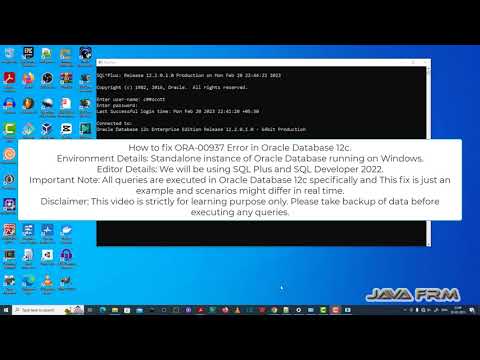
Found 37 images related to not a single-group group function theme


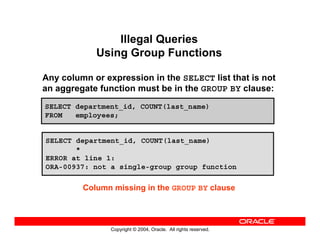

![Oracle - Error] ORA-00937: 단일 그룹의 그룹 함수가 아닙니다. - Oracle - Error] Ora-00937: 단일 그룹의 그룹 함수가 아닙니다. -](https://blog.kakaocdn.net/dn/rQskj/btqOoNSuIkm/9hbJ6FbLcPPnQgUaFpmHtK/img.png)


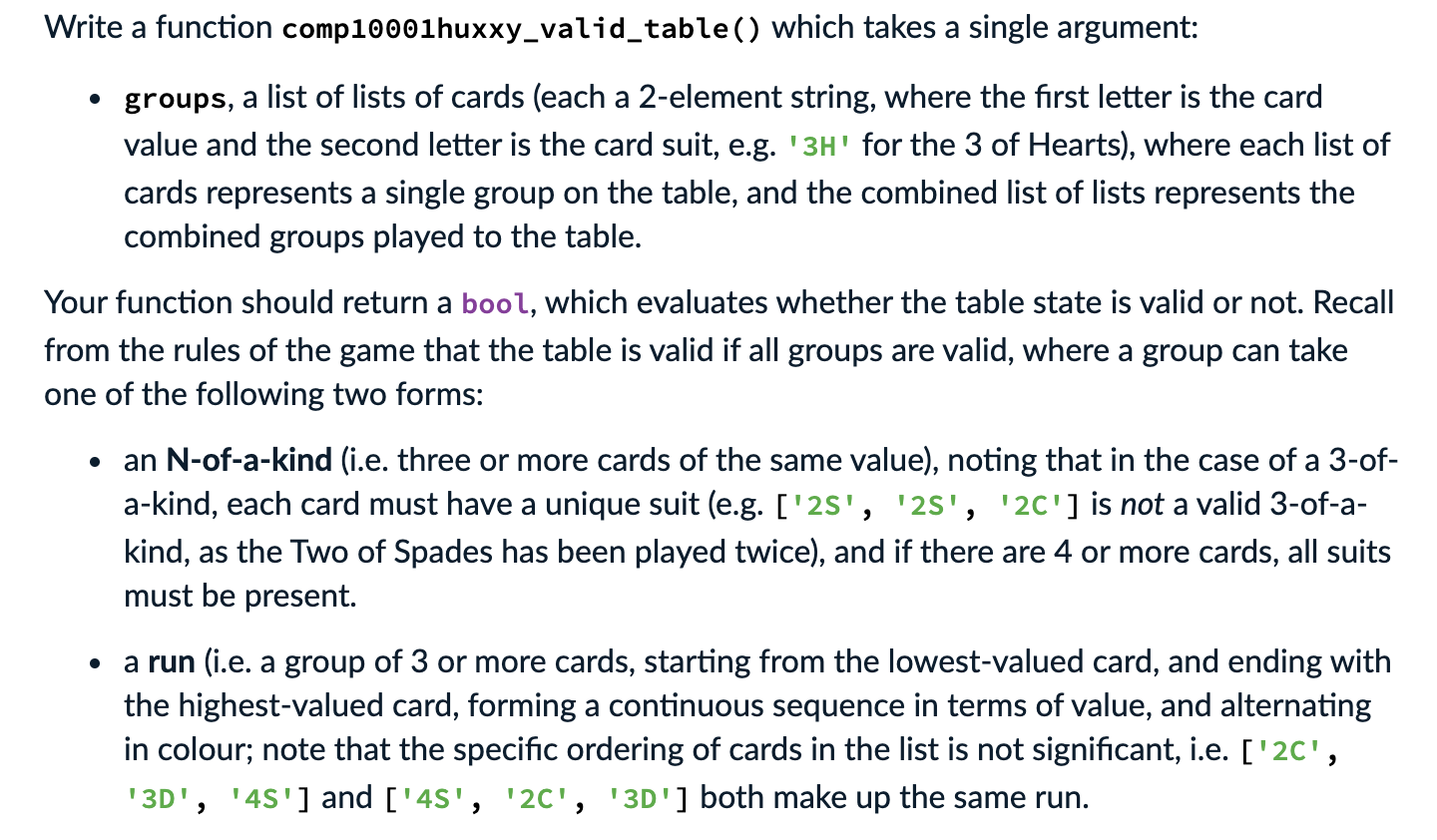
![How to Aggregate Data Using Group By in SQL [Updated] How To Aggregate Data Using Group By In Sql [Updated]](https://www.simplilearn.com/ice9/free_resources_article_thumb/group_by_in_sql.jpg)



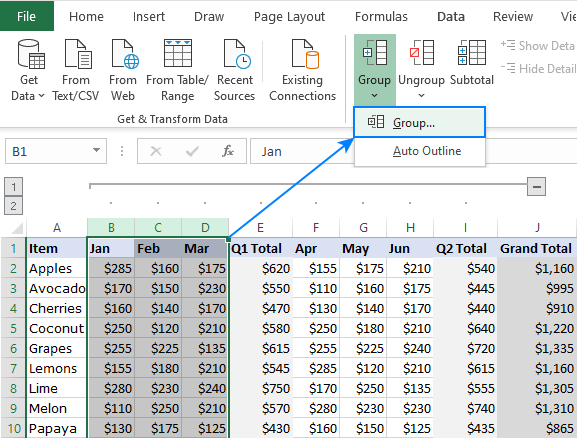




:max_bytes(150000):strip_icc()/Term-Definitions_Product-Line-Final-58870113a3ca4770a85cabf3549894bb.jpg)
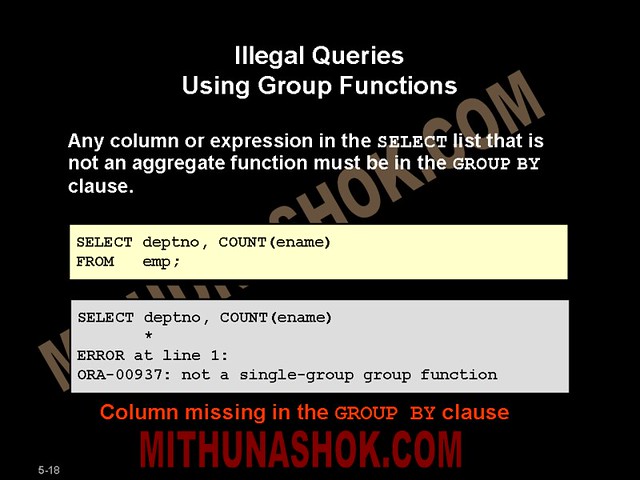

Article link: not a single-group group function.
Learn more about the topic not a single-group group function.
- SQL not a single-group group function – oracle – Stack Overflow
- ORA-00937: not a single-group function – TekStream Solutions
- ORA-00937: not a single-group group function – IBM
- ORA-00937: not a single-group group function – IBM
- Using the Group Functions Questions – Tutorialspoint
- How to Fix a ‘Not a GROUP BY Expression’ Error | LearnSQL.com
- ORA-00936: missing expression – TekStream Solutions
- ORA-00937: not a single-group group function tips
- ORA-00937: not a single-group group function Solution
- ORA-00937: not a single-group group function
- not a single group function – Oracle Forums
- Oracle / PLSQL: ORA-00937 Error Message – TechOnTheNet
See more: nhanvietluanvan.com/luat-hoc